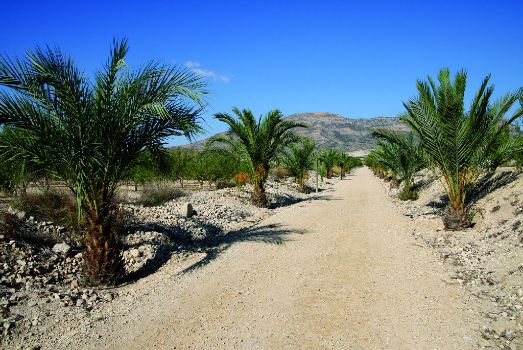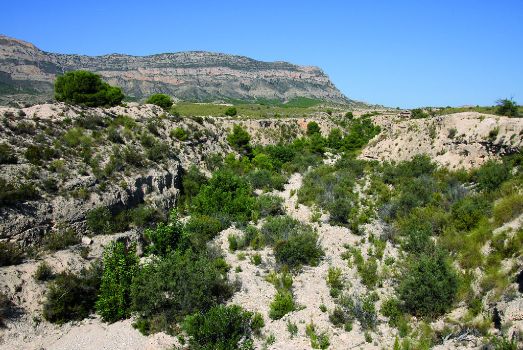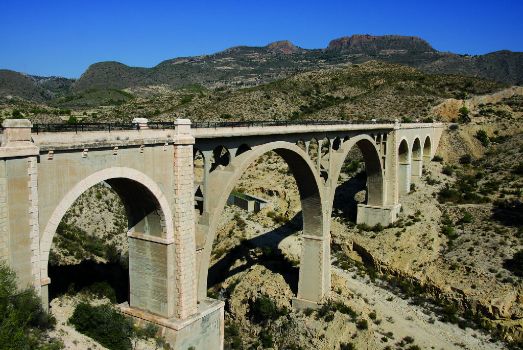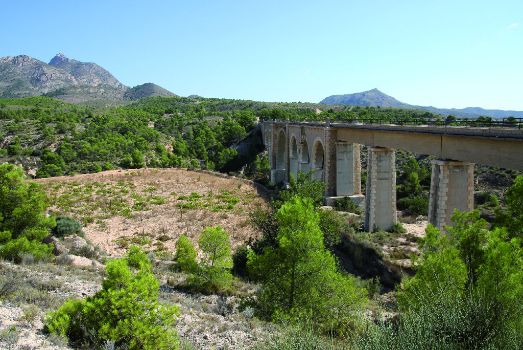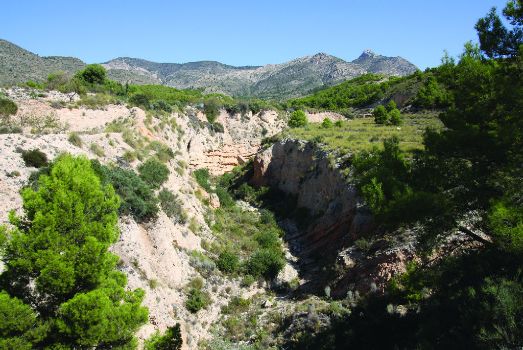Net of Natural
Trails

Maigmó Nature Trail
Description
Los Alfares route
In the 1920s, in order to provide an outlet for the important industrial production of the city of Alcoy via the port of Alicante, the construction of a railway line began, whose route is now taken advantage of by this Nature Trail. The work, which began under the Guadalhorce Railway Plan during General Primo de Rivera’s dictatorship, was never completed because of the Civil War.

The course of this Nature Trail, which is perfectly signposted, begins at the railway halt of Agost, where there is a bicycle park. A few metres after its starting-point, you will come to some fields where young garlic is grown and, leaving the tarmacked lanes behind you, you will see some old clay extraction facilities and the famous crops of the Vinalopó bagged grape variety, which is highly appreciated as table fruit.
This part of the route is presided by the majestic Sierra del Cid, while in the vicinity of the route there is a brick factory and the town of Agost.
The path continues along a green metal bridge over the road which will take trail users to a new crop-lined section where they will be accompanied by palm (Phoenix sp.), fig (Ficus carica) and carob (Ceratonia siliqua) trees. From time to time, you will be able to see the odd irrigation pond. One of them, which is totally covered by a green plant that holds water in its fleshy leaves, known as lion’s nail in Spain (Carpobrotus edulis), is especially obvious.

A little further on, the path runs through a cutting dug out to level the railway track. On this part of the route, you can spot the land that was dug out deeply and the bridges that were built for the railway and, continuing on your way, you can also see a stockpile of crushed stone (ballast), which should have been used for the railway tracks. When you have passed this point, the trail continues between wooden barriers and turns round a bend in the direction of the Sierra del Cid, just before a large terrace for farming.
The itinerary continues along a cemented section of track and crosses a couple of bridges, from whose slopes you can see a good many burrows evidencing an abundance of rabbits (Oryctolagus cuniculus) in the area.
The route passes close to an irrigation pond and some interpretation panels of the birdlife in the area, including the noteworthy red-billed chough (Pyrrhocorax pyrrhocorax) and the common cuckoo (Cuculus canorus). On this stretch of the route, you can see a tobacco-related plant that is commonly known as Moorish tobacco. Its scientific name (Nicotiana glauca), reveals its close relationship to tobacco (Nicotiana tabacum) although this species shares another toxin called anabasine, which is similar to nicotine.
The route continues and, after crossing a watercourse, it carries straight on until it reaches the first tunnel, which was used as a munitions dump in the Civil War. On the hillside that is just above it, you can still see a look-out post. After crossing the tunnel, the Nature Trail meets the sidings that were designed to prevent passers-by from being run over as the track was designed to be used not only by the train but also as a transit area.

A little further on from this tunnel, the path comes to the first viaduct, known as Forn del Vidre. In this large bridge, you can see the change that occurred in civil engineering in the period, which went from building in stone to the use of concrete. From this bridge, you can also see the construction works of an irrigation dam that never came into operation.
Continuing along the track, the trail passes once again through a cutting where a metal mesh prevents stones from falling. A little further ahead, another stockpile of ballast stone can be seen, from where the route continues straight ahead passing by a large reservoir until it reaches a resting area.
After leaving the resting area, the route reaches a crossroads, where trail users can see an old, small white hut and a sign that shows the name of the place, "Hacienda El Palomeret", an area that was very controversial in the 1970s owing to the planning of a large residential area which, in the end, was never built.

At this point, the trail continues straight ahead along a tarmacked surface for a few metres as far as the next large viaduct, whose construction specifications are similar to the previous one. It then crosses a watercourse to reach the next tunnel, at whose exit you will find a straight stretch with a wooden rail on both sides as far as a crossroads that leads up from Agost. The route continues straight ahead in the direction of two aqueducts, which cross it, and of another tunnel, at whose entrance some panels inform trail users about the crops in the watercourse.
A little further on there is a stone and mortar irrigation dam, an engineering work that is much older than the previous ones and which in bygone days was used to dam water. The trail continues to now reach the next tunnel, which is overseen by a large pine grove that has a bench at its base and an evergreen shrub covering one of its walls. Continuing on its way, the route carries on until it crosses a couple more tunnels, including a large protective wall.
After the last tunnel, which is unlit as is indicated by a sign, the Nature Trail draws to its end in a clay extraction area.
Sites of interest
Profile
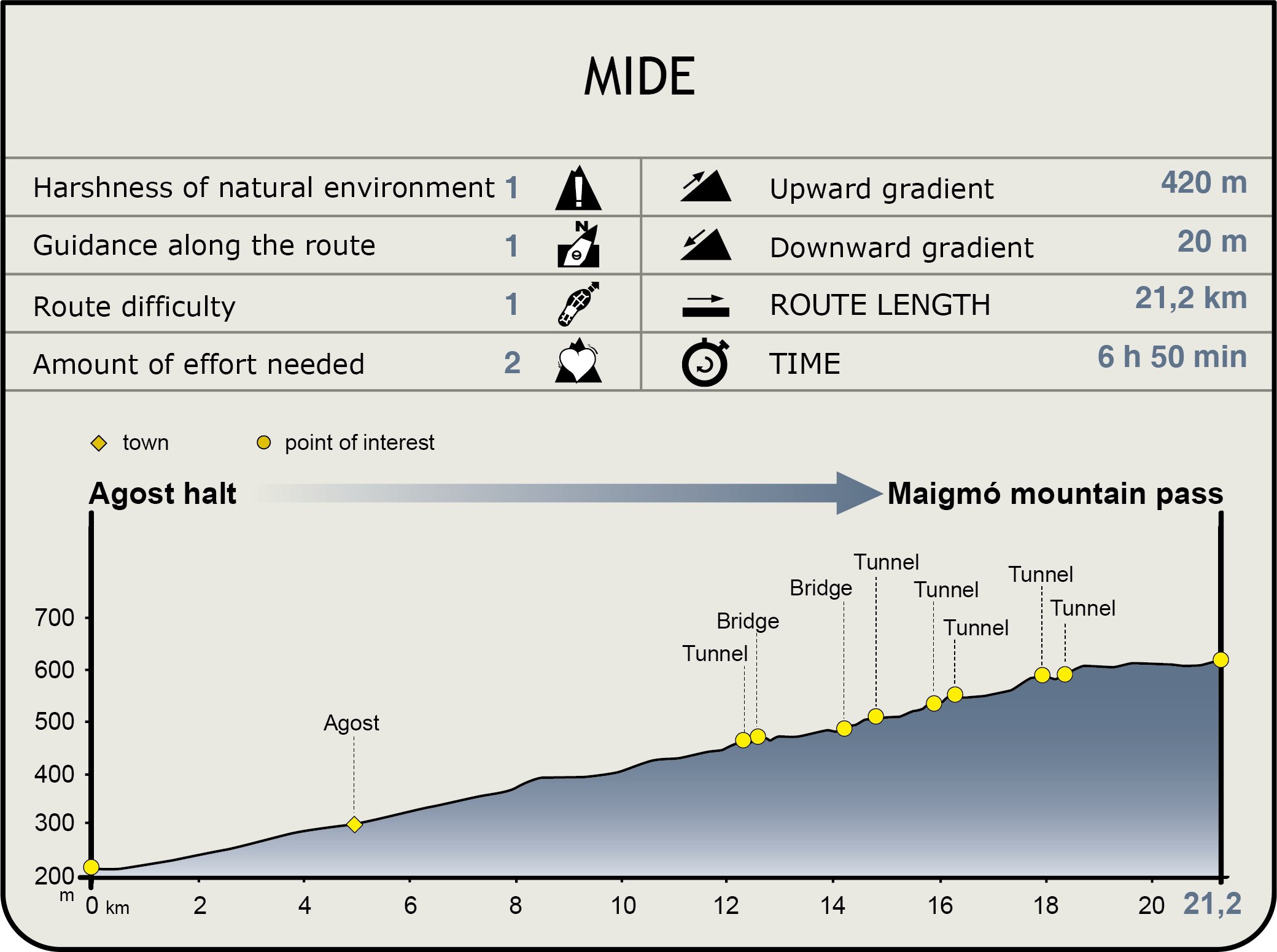
(Calculated according to the MIDE criteria for an average excursionist with a light load)
Highlights
Further information
The "Día de la Vella"
This unusual event, which is held three weeks after Ash Wednesday, is the most famous local celebration in Agost. Its origin, which dates back to time immemorial, basically consists in hanging some "velles", dolls that represent typical customs or places in the town, on the doors of houses and schools.
As an unusual feature, these dolls usually include signs simulating what the "velles" are saying and which, in most cases, refer to real events in the town in a satirical tone.
Agost pottery
Agost is a clay-related town with a pottery tradition that dates back to the 18th century, and its famous white clay botijos or drinking jugs are the products that have always given most fame to its craftsmen and women, due to the pleasant taste they leave in the water.
Half of the potters that are currently active continue their work using traditional techniques, with clay from the area, modelling pieces by hand and firing the products in Arab firewood furnaces.
In order to immerse visitors in the town’s pottery tradition, the Town Council of Agost has set up a museum in an old potter’s workshop which was in use until 1975. It has also created a route that tours the houses-workshops in the town, the settling tanks, the water supply fountain and an old mine.
Multimedia
Downloads
GPS Downloads
Cyclability
TYPE OF ROAD, PORTAGES & DIFFICULTY
SAFETY RECOMMENDATIONS
- It features multiple crossroads and access points to adjacent properties. It also has several intersections with roads and/or paved paths with little traffic. Pay special attention to a section shared with a road open to motorized traffic.
- The route passes through 6 tunnels without artificial lighting, so it is recommended to carry a flashlight. It also crosses 2 footbridges and 2 viaducts.
GENERAL RECOMMENDATIONS
- Find out about the technical aspects of the route and the weather on the day.
- Take care of the environment. Take care not to disturb animals or damage vegetation. Respect private areas.
- You must give priority to pedestrians and comply with general traffic rules.
- The environment in which you will be riding is open, free to move around and an area where many activities are carried out (sporting, forestry, livestock and agricultural activities). Always have an understanding, prudent, responsible and respectful attitude.




